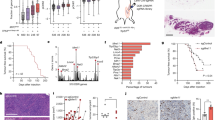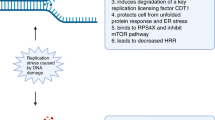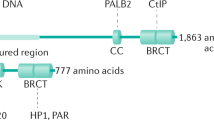Abstract
Defects in the detection and repair of DNA double-strand breaks (DSBs) have been causatively linked to tumourigenesis. Moreover, inhibition of DNA damage responses (DDR) can increase the efficacy of cancer therapies that rely on generation of damaged DNA. DDR must occur within the context of chromatin, and there have been significant advances in recent years in understanding how the modulation and manipulation of chromatin contribute to this activity. One particular covalent modification of a histone variant—the phosphorylation of H2AX—has been investigated in great detail and has been shown to have important roles in DNA DSB responses and in preventing tumourigenesis. These studies are reviewed here in the context of their relevance to cancer therapy and diagnostics. In addition, there is emerging evidence for contributions by proteins involved in mediating higher order structure to DNA DSB responses. The contributions of a subset of these proteins—linker histones and high-mobility group box (HMGB) proteins—to DDR and their potential significance in tumourigenesis are discussed.
This is a preview of subscription content, access via your institution
Access options
Subscribe to this journal
Receive 50 print issues and online access
$259.00 per year
only $5.18 per issue
Buy this article
- Purchase on Springer Link
- Instant access to full article PDF
Prices may be subject to local taxes which are calculated during checkout

Similar content being viewed by others
References
Alami R, Fan T, Pack S, Sonbuchner TM, Besse A, Lin Q et al. (2003). Mammalian linker-histone subtypes differentially affect gene expression in vivo. Proc Natl Acad Sci 100: 5920–5925.
Ausio J . (2000). Are linker histones (histone H1) dispensable for survival? BioEssays 22: 873–877.
Bartkova J, Horejsi Z, Koed K, Kramer A, Tort F, Zieger K et al. (2005). DNA damage response as a candidate anti-cancer barrier in early human tumorigenesis. Nature 434: 864–870.
Bassing CH, Suh H, Ferguson DO, Chua KF, Manis J, Eckersdorf M et al. (2003). Histone H2AX: a dosage-dependent suppressor of oncogenic translocations and tumors. Cell 114: 359–370.
Bergeron S, Madathiparambil T, Swanson PC . (2005). Both high mobility group (HMG)-boxes and the acidic tail of HMGB1 regulate recombination-activating gene (RAG)-mediated recombination signal synapsis and cleavage in vitro. J Biol Chem 280: 31314–31324.
Bianchi ME, Agresti A . (2005). HMG proteins: dynamic players in gene regulation and differentiation. Curr Opin Genet Dev 15: 496–506.
Bredemeyer AL, Sharma GG, Huang CY, Helmink BA, Walker LM, Khor KC et al. (2006). ATM stabilizes DNA double-strand-break complexes during V(D)J recombination. Nature 442: 466–470.
Campisi J . (2005). Suppressing cancer: the importance of being senescent. Science 309: 886–887.
Celeste A, Difilppantonio S, Difilppantonio MJ, Fernandez-Capetillo O, Pilch DR, Sedelnikova OA et al. (2003). H2AX haploinsufficiency modifies genomic stability and tumor susceptibility. Cell 114: 371–383.
Costelloe T, Fitzgerald J, Murphy NJ, Flaus A, Lowndes NF . (2006). Chromatin modulation and the DNA damage response. Exp Cell Res 312: 2677–2686.
Cowell IG, Durkacz BW, Tilby MJ . (2005). Sensitization of breast carcinoma cells to ionizing radiation by small molecule inhibitors of DNA-dependent protein kinase and ataxia telangiectsia mutated. Biochem Pharmacol 71: 13–20.
Dai Y, Wong B, Yen YM, Oettinger MA, Kwon J, Johnson RC . (2005). Determinants of HMGB proteins required to promote RAG1/2-recombination signal sequence complex assembly and catalysis during V(D)J recombination. Mol Cell Biol 25: 4413–4425.
Dokmanovic M, Marks PA . (2005). Prospects: histone deacetylase inhibitors. J Cell Biochem 96: 293–304.
Downs JA, Kosmidou E, Morgan A, Jackson SP . (2003). Suppression of homologous recombination by the Saccharomyces cerevisiae linker histone. Mol Cell 11: 1685–1692.
Downs JA, Nussenzweig MC, Nussenzweig A . (2007). Chromatin dynamics and the preservation of genetic information. Nature 447: 951–958.
Fan Y, Nikitina T, Zhao J, Fleury TJ, Bhattacharyya R, Bouhassira EE et al. (2005). Histone h1 depletion in mammals alters global chromatin structure but causes specific changes in gene regulation. Cell 123: 1199–1212.
Foster ER, Downs JA . (2005). Histone H2A phosphorylation in DNA double-strand break repair. FEBS Journal 272: 3231–3240.
Fraga MF, Ballestar E, Villar-Garea A, Boix-Chornet M, Espada J, Schotta G et al. (2005). Loss of acetylation at Lys16 and trimethylation at Lys20 of histone H4 is a common hallmark of human cancer. Nat Genet 37: 391–400.
Franco S, Gostissa M, Zha S, Lombard DB, Murphy MM, Zarrin AA et al. (2006). H2AX prevents DNA breaks from progressing to chromosome breaks and translocations. Mol Cell 21: 201–214.
Funayama R, Saito M, Tanobe H, Ishikawa F . (2006). Loss of linker histone H1 in cellular senescence. J Cell Biol 175: 869–880.
Gallmeier E, Winter JM, Cunningham SC, Kahn SR, Kern SE . (2005). Novel genotoxicity assays identify norethindrone to activate p53 and phosphorylate H2AX. Carcinogenesis 26: 1811–1820.
Gaudet F, Hodgson JG, Eden A, Jackson-Grusby L, Dausman J, Gray JW et al. (2003). Induction of tumors in mice by genomic hypomethylation. Science 300: 489–492.
Gorgoulis VG, Vassiliou LV, Karakaidos P, Zacharatos P, Kotsinas A, Liloglou T et al. (2005). Activation of the DNA damage checkpoint and genomic instability in human precancerous lesions. Nature 434: 907–913.
Hanahan D, Weinberg RA . (2000). The hallmarks of cancer. Cell 100: 57–70.
Harvey AC, Downs JA . (2004). What functions do linker histones provide? Mol Microbiol 53: 771–775.
Hasan S, Hottiger MO . (2002). Histone acetyl transferases: a role in DNA repair and DNA replication. J Mol Med 80: 463–474.
Hashimoto H, Sonoda E, Takami Y, Kimura H, Nakayama T, Tachibana M et al. (2007). Histone H1 variant, H1R is involved in DNA damage response. DNA Repair (in press).
Jackson SP . (2002). Sensing and repairing DNA double-strand breaks. Carcinogenesis 23: 687–696.
Kao J, Milano MT, Javaheri A, Garofalo MC, Chmura SJ, Weichselbaum RR et al. (2006). gamma-H2AX as a therapeutic target for improving the efficacy of radiation therapy. Curr Cancer Drug Targets 6: 197–205.
Konishi A, Shimizu S, Hirota J, Takao T, Fan Y, Matsuoka Y et al. (2003). Involvement of histone H1.2 in apoptosis induced by DNA double-strand breaks. Cell 114: 673–688.
Lavin MF, Delia D, Chessa L . (2006). ATM and the DNA damage response. EMBO Rep 7: 154–160.
Luger K, Mader AW, Richmond RK, Sargent DF, Richmond TJ . (1997). Crystal structure of the nucleosome core particle at 2.8 A resolution. Nature 389: 251–260.
Madhusudan S, Middleton MR . (2005). The emerging role of DNA repair proteins as predictive, prognostic and therapeutic targets in cancer. Cancer Treat Rev 31: 603–617.
Mahrhofer H, Burger S, Oppitz U, Flentje M, Djuzenova CS . (2006). Radiation induced DNA damage and damage repair in human tumor and fibroblast cell lines assessed by histone H2AX phosphorylation. Int J Radiat Oncol Biol Phys 64: 573–580.
Meng LH, Kohlhagen G, Liao ZY, Antony S, Sausville E, Pommier Y . (2005). DNA-protein cross-links and replication-dependent histone H2AX phosphorylation induced by aminoflavone (NSC 686288), a novel anticancer agent active against human breast cancer cells. Cancer Res 65: 5337–5343.
Michor F . (2005). Chromosomal instability and human cancer. Philos Trans R Soc Lond B Biol Sci 360: 631–635.
Morrison AJ, Shen X . (2005). DNA repair in the context of chromatin. Cell Cycle 4: 568–571.
Munshi A, Tanaka T, Hobbs ML, Tucker SL, Richon VM, Meyn RE . (2006). Vorinostat, a histone deacetylase inhibitor, enhances the response of human tumor cells to ionizing radiation through prolongation of gamma-H2AX foci. Mol Cancer Ther 5: 1967–1974.
Murr R, Loizou JI, Yang YG, Cuenin C, Li H, Wang ZQ et al. (2006). Histone acetylation by Trrap-Tip60 modulates loading of repair proteins and repair of DNA double-strand breaks. Nat Cell Biol 8: 91–99.
Nagaki S, Yamamoto M, Yumoto Y, Shirakawa H, Yoshida M, Teraoka H . (1998). Non-histone chromosomal proteins HMG1 and 2 enhance ligation reaction of DNA double-strand breaks. Biochem Biophys Res Commun 246: 137–141.
Neuman AA, Reddel RR . (2002). Telomere maintenance and cancer- look, no telomerase. Nat Rev Cancer 2: 879–884.
Peters AH, O'Carroll D, Scherthan H, Mechtler K, Sauer S, Schofer C et al. (2001). Loss of the Suv39 h histone methyltransferases impairs mammalian heterochromatin and genome stability. Cell 107: 323–337.
Peterson CL, Cote J . (2004). Cellular machineries for chromosomal DNA repair. Genes Dev 18: 602–616.
Qian X, LaRochelle WJ, Ara G, Wu F, Petersen KD, Thougaard A et al. (2006). Activity of PXD101, a histone deacetylase inhibitor, in preclinical ovarian cancer studies. Mol Cancer Ther 5: 2086–2095.
Qvarnstrom OF, Simonsson M, Johansson KA, Nyman J, Turesson I . (2004). DNA double strand break quantification in skin biopsies. Radiother Oncol 72: 311–317.
Ramiro AR, Jankovic M, Callen E, Difilippantonio S, Chen HT, McBride KM et al. (2006). Role of genomic instability and p53 in AID-induced c-myc-Igh translocations. Nature 440: 105–109.
Raucci A, Palumbo R, Bianchi ME . (2007). HMGB1: a signal of necrosis. Autoimmunity 40: 285–289.
Redon C, Pilch DR, Rogakou E, Sedelnikova OA, Newrock K, Bonner WM . (2002). Histone H2A variants H2AX and H2AZ. Curr Opin Genet Dev 12: 162–169.
Reeves R, Adair JE . (2005). Role of high mobility group (HMG) chromatin proteins in DNA repair. DNA Repair (Amst) 4: 926–938.
Reina-San-Martin B, Difilppantonio S, Hanitsch L, Masilamani RF, Nussenzweig A, Nussenzweig MC . (2003). H2AX is required for recombination between immunoglobulin switch regions but not for intra-switch region recombination or somatic hypermutation. J Exp Med 197: 1767–1778.
Scaffidi P, Misteli T, Bianchi ME . (2002). Release of chromatin protein HMGB1 by necrotic cells triggers inflammation. Nature 418: 191–195.
Seligson DB, Horvath S, Shi T, Yu H, Tze S, Grunstein M et al. (2005). Global histone modification patterns predict risk of prostate cancer recurrence. Nature 435: 1262–1266.
Stros M, Cherny D, Jovin TM . (2000). HMG1 protein stimulates DNA end joining by promoting association of DNA molecules via their ends. Eur J Biochem 267: 4088–4097.
Sun Y, Jiang X, Chen S, Fernandes N, Price BD . (2005). A role for the Tip60 histone acetyltransferase in the acetylation and activation of ATM. Proc Natl Acad Sci USA 102: 13182–13187.
Taguchi A, Blood DC, del Toro G, Canet A, Lee DC, Qu W et al. (2000). Blockade of RAGE-amphoterin signalling suppresses tumour growth and metastases. Nature 405: 354–360.
Taneja N, Davis M, Choy JS, Beckett MA, Singh R, Kron SJ et al. (2004). Histone H2AX phosphorylation as a predictor of radiosensitivity and target for radiotherapy. J Biol Chem 279: 2273–2280.
Teng S-C, Zakian VA . (1999). Telomere–telomere recombination is an efficient bypass pathway for telomere maintenance in Saccharomyces cerevisiae. Mol Cell Biol 19: 8083–8093.
Thomas JO, Travers AA . (2001). HMG1 and 2, and related ‘archetectural’ DNA binding proteins. Trends Biochem Sci 26: 167–174.
Travers AA . (2003). Priming the nucleosome: a role for HMGB proteins? EMBO Rep 4: 131–136.
Ueda T, Shirakawa H, Yoshida M . (2002). Involvement of HMGB1 and HMGB2 proteins in exogenous DNA integration reaction into the genome of HeLa S3 cells. Biochim Biophys Acta 1593: 77–84.
van Attikum H, Gasser SM . (2005). The histone code at DNA breaks: a guide to repair? Nat Rev Mol Cell Biol 6: 757–765.
Vogel H, Lim D-S, Karsenty G, Finegold M, Hasty P . (1999). Deletion of Ku86 causes early onset of senescence in mice. Proc Natl Acad Sci 96: 10770–10775.
Williams RS, Williams JS, Tainer JA . (2007). Mre11-Rad50-Nbs1 is a keystone complex connecting DNA repair machinery, double-strand break signaling, and the chromatin template. Biochem Cell Biol 85: 509–520.
Xu WS, Parmigiani RB, Marks PA . (2007). Histone deacetylase inhibitors: molecular mechanisms of action. Oncogene 26: 5541–5552.
Yamanaka S, Katayama E, Yoshioka K, Nagaki S, Yoshida M, Teraoka H . (2002). Nucleosome linker proteins HMGB1 and histone H1 differentially enhance DNA ligation reactions. Biochem Biophys Res Commun 292: 268–273.
Yoshida K, Morita T . (2004). Control of radiosensitivity of F9 mouse teratocarcinoma cells by regulation of histone H2AX gene expression using a tetracycline turn-off system. Cancer Res 64: 4131–4136.
Yu T, MacPhail SH, Banath JP, Klokov D, Olive PL . (2006). Endogenous expression of phosphorylated histone H2AX in tumors in relation to DNA double-strand breaks and genomic instability. DNA Repair (Amst) 5: 935–946.
Author information
Authors and Affiliations
Corresponding author
Rights and permissions
About this article
Cite this article
Downs, J. Chromatin structure and DNA double-strand break responses in cancer progression and therapy. Oncogene 26, 7765–7772 (2007). https://doi.org/10.1038/sj.onc.1210874
Published:
Issue Date:
DOI: https://doi.org/10.1038/sj.onc.1210874
Keywords
This article is cited by
-
The Warburg effect: molecular aspects and therapeutic possibilities
Molecular Biology Reports (2015)
-
Quiescence and γH2AX in neuroblastoma are regulated by ouabain/Na,K-ATPase
British Journal of Cancer (2012)
-
Histone acetylation by CBP and p300 at double-strand break sites facilitates SWI/SNF chromatin remodeling and the recruitment of non-homologous end joining factors
Oncogene (2011)



